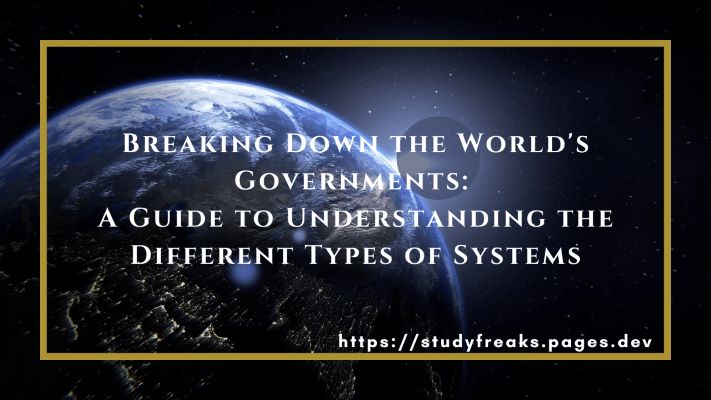Breaking Down the World's Governments: A Guide to Understanding the Different Types of Systems

Governments play a significant role in the socio-economic and political structure of a country. Governments can be classified into different types based on their structure, ideology, and mode of operation. In this article, we will explore the different types of government systems, their characteristics, subcategories, and examples.
Table of Contents
Monarchy
Monarchy is a type of government where a single person, known as a monarch, has complete control over the government. The monarch usually inherits the position, and the system is often referred to as a hereditary monarchy. Monarchies can be further divided into two types: Absolute monarchy and Constitutional monarchy.
- Absolute Monarchy: In an absolute monarchy, the monarch has complete control over the government and the people. The monarch's word is law, and there are no checks and balances on their power. Countries that have absolute monarchies include Saudi Arabia, Brunei, and Oman.
- Constitutional Monarchy: In a constitutional monarchy, the monarch's power is limited by a constitution or a set of laws. The monarch is usually a ceremonial figurehead, with the real power held by an elected parliament. Countries that have constitutional monarchies include the United Kingdom, Japan, and Sweden.
Democracy
Democracy is a type of government where the people have the power to elect their leaders and make decisions about the government. Democracies can be divided into two types: Direct democracy and Representative democracy.
- Direct Democracy: In a direct democracy, every citizen has a direct say in the government's decision-making process. Citizens can vote on laws and policies directly. Countries that have direct democracies include Switzerland, where citizens can vote on important issues directly through referendums.
- Representative Democracy: In a representative democracy, the people elect representatives to make decisions on their behalf. The elected representatives form a parliament or a congress, which makes decisions on behalf of the people. Countries that have representative democracies include the United States, India, and Germany.
Dictatorship
Dictatorship is a type of government where a single person or a small group of people has complete control over the government and the people. The system is often referred to as a totalitarian government. Dictatorships can be divided into two types: Military dictatorship and Civilian dictatorship.
- Military Dictatorship: In a military dictatorship, the military controls the government, and the leaders are usually high-ranking military officials. Military dictatorships are usually established after a coup or a revolution. Countries that have military dictatorships include Myanmar, North Korea, and Sudan.
- Civilian Dictatorship: In a civilian dictatorship, a single person or a small group of people control the government. Civilian dictatorships are usually established through a rigged election or a fraudulent referendum. Countries that have civilian dictatorships include Cuba, China, and Zimbabwe.
Theocracy
Theocracy is a type of government where the rulers claim to be ruling on behalf of a higher power, such as a god or a deity. The system is often associated with religious institutions. Theocratic governments can be found in different parts of the world and can be divided into two types: Ecclesiocracy and Secular Theocracy.
- Ecclesiocracy: In an Ecclesiocracy, the religious leaders or institutions have a significant role in the governance of the country. The laws and policies of the country are based on religious doctrines. Examples of countries with an Ecclesiocracy include Iran, where the Ayatollahs hold significant power in the government.
- Secular Theocracy: In a secular theocracy, the government is not based on religious doctrine, but the rulers claim to have a divine mandate to govern. Examples of countries with a secular theocracy include the Vatican City, where the Pope is the head of the state.
Republic
A republic is a type of government where the people have the power to elect their leaders, but the country is not headed by a monarch. In a republic, the power is held by the people, and the government is run by elected representatives. Republics can be divided into two types: Presidential Republic and Parliamentary Republic.
- Presidential Republic: In a Presidential Republic, the head of the government is a president who is elected by the people. The president has significant power and is not accountable to the parliament or the congress. Countries that have Presidential Republics include the United States, Brazil, and Mexico.
- Parliamentary Republic: In a Parliamentary Republic, the head of the government is a prime minister who is elected by the parliament or the congress. The prime minister is accountable to the parliament or the congress and can be removed from office through a vote of no confidence. Countries that have Parliamentary Republics include Germany, Italy, and India.
Anarchy
Anarchy is a type of government where there is no government, and the people are free to make their own decisions. Anarchism is a political ideology that advocates for the abolition of all forms of government and the establishment of a society based on voluntary cooperation and mutual aid. While there are no countries that are officially classified as anarchic, there have been instances in history where anarchy has prevailed in certain regions.
Conclusion
In conclusion, governments play a crucial role in the socio-economic and political structure of a country. There are different types of government systems, each with its own unique characteristics, subcategories, and examples. It is essential to understand the different types of government systems to have a better understanding of the world around us.

